 Most of you know I roll my own cigars. There are a lot of reasons for me to roll my own. The first reason is that rolling my own cigars fits into my DIY lifestyle. As plain people living off-grid, we try our best to forego as many mass industrial processes as possible in just about every area of our lives. IF you choose to exercise your freedom to smoke cigars (like I do,) then you have to realize that when you make the choice to spend your money on cigars, you are making a lot of sub-choices within that choice. Many of those choices you may never have thought about.
Most of you know I roll my own cigars. There are a lot of reasons for me to roll my own. The first reason is that rolling my own cigars fits into my DIY lifestyle. As plain people living off-grid, we try our best to forego as many mass industrial processes as possible in just about every area of our lives. IF you choose to exercise your freedom to smoke cigars (like I do,) then you have to realize that when you make the choice to spend your money on cigars, you are making a lot of sub-choices within that choice. Many of those choices you may never have thought about.
MYTH #1 – Because a cigar is advertised as handmade, does not mean that it isn’t made in a large factory using industrial processes and equipment.
When you buy a box or bundle of cigars, you are making the choice to support a long list of production practices, including industrial manufacturing and the factory ethos. You are making the choice to support a system of production that often elevates corporate marketing decisions above the actual quality of the product. This means that corporations are making decisions about what goes into your cigar (and into the production of it) based on how it will look more than what is best for the health and enjoyment of the end user. As much as 75% – 80% of the price of a cigar can directly represent cosmetic decisions made to increase the visual elements of the product that have nothing to do with the actual quality or smokeability of the cigar. I learned this when I first began off-grid homesteading…
We would be disappointed at our inability to grow fruits and vegetables that looked as appealing as the store bought kind. But we noticed our natural, home-grown produce tasted better and was better for us than the store bought kind. We learned that industrial/corporate farmers often make decisions based on what they want the finished fruit/vegetable/grain, etc. to look like, rather than what is best for the product and the customer.
Industrial producers learned that using the copious application of chemicals and other questionable processes, they could “manufacture” produce that LOOKED delicious, even if it had 1/3 the nutritive and health benefits of the naturally grown alternative. Food products are made to look good and last long in the store using dangerous and questionable practices, all the while damaging the actual end product and the customer. For this reason buyers have to eat up to 3 times as much food in order to satisfy the nutritional demands their body has. Most of that food is nutrient/vitamin/mineral deficient filler that causes obesity, diseases, and can have other damaging effects. All so the product can be made to look good in the store (and bring in more money.)
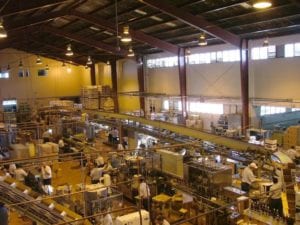 Cigars are no different. When people are regularly paying $10 to $20 a stick for premium cigars, they have to make buying decisions on some criteria, and usually the end user has very little real and practical knowledge about how cigars are produced. The result? The cosmetic elements of the cigar are the primary means of most users making buying decisions. This reality drives a downward spiral that negatively effects the real quality of the smokes themselves.
Cigars are no different. When people are regularly paying $10 to $20 a stick for premium cigars, they have to make buying decisions on some criteria, and usually the end user has very little real and practical knowledge about how cigars are produced. The result? The cosmetic elements of the cigar are the primary means of most users making buying decisions. This reality drives a downward spiral that negatively effects the real quality of the smokes themselves.
And as I said, most users have very little real expertise in understanding cigars. They know what they like sometimes, but they know very little about what elements are present in a cigar and what those elements produce enjoyment-wise. The point is that just because a cigar is “hand rolled” doesn’t mean that it isn’t a mass-produced industrial product with all that that implies.
For example…
MYTH #2 – A “bold” or “strong” cigar will have a dark wrapper (like a Maduro.) A mild smoke will have a light colored wrapper.
Nope. Most cigar smokers believe the wrapper color is the primary way to determine the “strength” or boldness of a smoke. I would guesstimate that 90% of the cigars smokers I’ve known (and I’ve known a lot of them) have indicated that they choose their cigars based on the “strength” of the cigar, and they believe that the color of the wrapper is what indicates this strength. This is absolutely false. The blackest wrapper can be added to the mildest cigar fillers and binders and have almost no real impact on the smoke itself. The wrapper… the ultra-thin membrane that gives a cigar it’s color and look… has next to zero effect on the strength or mildness of a cigar. It can affect the smokeability and the enjoyment. We all love a smooth, silky wrapper, but don’t confuse cosmetics with the reality of the thing. Like with people, what is painted and put on the outside has little to do with what is on the inside.
MYTH #3 – Premium or expensive cigars are fundamentally better (you get what you pay for.)
This is a tricky one because it is only partially true. If you pay a lot for a cigar, you definitely get a better looking 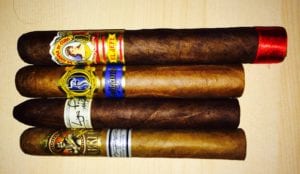 smoke. And your cigar may be substantively better than a cheaper smoke only because we are comparing apples and filing cabinets. It is true that some “value” cigars use cheaper materials, short fillers, and aren’t constructed as well. But none of this means it has to be that way. Nor does it speak at all to the actual quality of the premium cigar. I’ve had economy cigars that were every bit as good, or better, than a premium smoke.
smoke. And your cigar may be substantively better than a cheaper smoke only because we are comparing apples and filing cabinets. It is true that some “value” cigars use cheaper materials, short fillers, and aren’t constructed as well. But none of this means it has to be that way. Nor does it speak at all to the actual quality of the premium cigar. I’ve had economy cigars that were every bit as good, or better, than a premium smoke.
Because most cigar buyers make their selection based on cosmetic reasons, factories spend millions on purely cosmetic decisions. That makes total economic sense. If you aren’t going to educate smokers, then you have to sell to what they think and not what they know. Like I said, up to 80% of the price of your cigar represents things that have nothing to do with the final smoke.
As I mentioned before, decisions are made all along the supply line that effect the final product, often negatively, but based solely on how it will make the final cigar product look. Inferior tobaccos are selected if they look better and will be easier to work, regardless of their actual quality.
Then the tobacco gets to the factory…
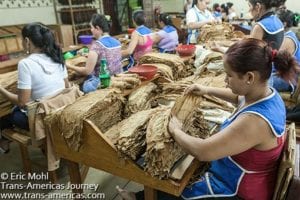 …where dozens and dozens of employees are hired to grade, sort, color match, etc. the tobacco based solely on what size/color/style the cigar will eventually be. A recent documentary stated that with many premium brands as many as 500 people have handled your cigar tobacco by the time you smoke it (some say 300, but still.) That is because you are being tricked into embracing the romantic idea that a single roller takes the tobaccos and forms your cigar and then magically all 20 or 25 cigars end up looking perfectly identical in your beautiful box or bundle. Not at all. Dozens of rollers are working on the same cigar size and before they get the tobacco, dozens more have been using machines to flatten and sort the tobacco. Most of these color sorters are women because women have the ability to see more color difference nuances than men. And this is just in the factory. This is not talking about what goes on before the sorters get the tobacco.
…where dozens and dozens of employees are hired to grade, sort, color match, etc. the tobacco based solely on what size/color/style the cigar will eventually be. A recent documentary stated that with many premium brands as many as 500 people have handled your cigar tobacco by the time you smoke it (some say 300, but still.) That is because you are being tricked into embracing the romantic idea that a single roller takes the tobaccos and forms your cigar and then magically all 20 or 25 cigars end up looking perfectly identical in your beautiful box or bundle. Not at all. Dozens of rollers are working on the same cigar size and before they get the tobacco, dozens more have been using machines to flatten and sort the tobacco. Most of these color sorters are women because women have the ability to see more color difference nuances than men. And this is just in the factory. This is not talking about what goes on before the sorters get the tobacco.
Your actual cigar roller (some premium brands have as many as three rollers working on a single cigar, others – very few – have a single roller who does the whole process,) is trained to utilize some techniques (such as vein removal, etc.) that take time and improve the looks of the cigar but that add nothing to the final product quality or smokeability (and can actually negatively affect the structural integrity of the cigar.)
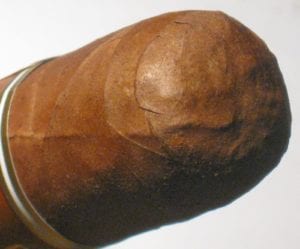 One of the most time consuming (requiring the most training, experience, and expertise) techniques in cigar rolling, is the application of the “cap.” Old, old time Cuban cigars never had a cap. Not back when they were the best cigars in the world. Everyone knew you just cut the cap off anyway (or bit it off.) So the cigars had a “curly head” or twist at the top. When I first started smoking cigars “curly heads” were top quality cigars that were made by beginner rollers who hadn’t mastered the end cap yet. Get this…. the part they hadn’t mastered, was the part you cut off anyway! So you could get better cigars for less money. If cigar makers were realistic and not maximizing profit based on looks alone, this would still be true.
One of the most time consuming (requiring the most training, experience, and expertise) techniques in cigar rolling, is the application of the “cap.” Old, old time Cuban cigars never had a cap. Not back when they were the best cigars in the world. Everyone knew you just cut the cap off anyway (or bit it off.) So the cigars had a “curly head” or twist at the top. When I first started smoking cigars “curly heads” were top quality cigars that were made by beginner rollers who hadn’t mastered the end cap yet. Get this…. the part they hadn’t mastered, was the part you cut off anyway! So you could get better cigars for less money. If cigar makers were realistic and not maximizing profit based on looks alone, this would still be true.
Making the cap is all about looks, and that’s fine. And hipster aficionados will argue with this. They’ll have extensive tutorials telling you about the importance of the cap and where to cut the nub so you don’t remove the under cap, etc. But the fact remains… the very best cigar rollers/manufacturers in the world do not put end caps on the cigars they make for themselves to smoke. Because the caps are purely cosmetic. I put them on there for most of my cigars I make for my close friends, but I never put them on my own that I roll for myself.
Yet this is the one step that takes the most time and takes the most experienced rollers to accomplish well. That’s like someone telling you they spent the most time, the most money, and hired the most expensive experts to make the cork in your wine. I can make cigar caps, and they end up looking pretty swell. But I don’t do it for my own cigars because I don’t care and I know better.
All of this costs money. Lots of money. And the best cigar rollers in the world do NOT buy premium cigars. That doesn’t mean they don’t smoke great cigars. Or that they don’t spend good money on them. They sometimes do. But they make sure they are getting what they pay for. Usually, they make their own, and they don’t put end caps on them, and they don’t spend money on all the dumb cosmetic things that are for tourists and not aficionados.
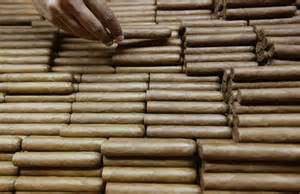 After your cigar is rolled it goes into the next sorting room where dozens of sorters wait to separate and sort the cigars by tiny gradients of color and other cosmetic issues. Other experts are hired to fix slight cosmetic deficiencies, and bands are then attached (more and more bands as time goes by… some premium brands now have as many as 4 separate cigar bands) that also use bands to cover up the most problematic areas of the cigar.
After your cigar is rolled it goes into the next sorting room where dozens of sorters wait to separate and sort the cigars by tiny gradients of color and other cosmetic issues. Other experts are hired to fix slight cosmetic deficiencies, and bands are then attached (more and more bands as time goes by… some premium brands now have as many as 4 separate cigar bands) that also use bands to cover up the most problematic areas of the cigar.
A friend brought me a very nice (and expensive!) Montecristo Espada. I took a picture of it there on the right. What a beautiful smoke! He paid almost $12 for it ($12 to $15 today in 2021.)
You can only see two bands in the picture, but the cigar had 3 bands. Right after this smoke, we smoked one of my hand rolled cigars. It was every bit as good, and I didn’t have to remove all those labels.
 It’s a grand and exquisite shell game. But are the cigars actually better? Better than what? I believe you can get a far superior cigar from a local, private roller (if you are blessed enough to know someone who can roll cigars.) Some small cigar shops actually have premium, experienced rollers who roll cigars for them. I believe you’ll prefer cigars handmade by a private roller using better quality (but perhaps cosmetically flawed) tobaccos. This leads to the next myth…
It’s a grand and exquisite shell game. But are the cigars actually better? Better than what? I believe you can get a far superior cigar from a local, private roller (if you are blessed enough to know someone who can roll cigars.) Some small cigar shops actually have premium, experienced rollers who roll cigars for them. I believe you’ll prefer cigars handmade by a private roller using better quality (but perhaps cosmetically flawed) tobaccos. This leads to the next myth…
MYTH #4 – Premium cigars use the best tobacco. (Only partially true)
While it is true that the biggest name brands and factories get first shot at all the tobacco crops, it is absolutely NOT true that the best overall quality tobacco goes to the premium factories. Certainly the best looking tobacco goes to the premium brands. But looks doesn’t always tell the whole story.
Some premium cigar brands advertise that their cigars have “aged” for years (or decades!) in special humidified rooms or storage cellars. While this may be technically true, that post-production aging can mellow and “marry” a cigar’s tobaccos, it doesn’t improve the overall quality very much. In fact, what these factories are marketing is the fact that their cigars wait to be shipped. Here’s the fact that matters: The time spent aging the tobacco BEFORE the cigars are made is much more indicative of the quality of the actual tobacco.
And what did we say? The Premium brands get first dibs and they buy up all the best looking tobacco. They buy it early and it goes into production quickly. This means that bulk buyers for cheaper brands or wholesale leaf dealers often end up buying bulk tobacco that has aged in the actual aging barns for years (or decades!) improving all the while. For this reason, individual rollers (like me!) can buy better actual total overall quality tobacco, than the premium brands. The tobacco may not look as cosmetically flawless (in the inside parts you never see,) but it is often better tobacco.
MYTH #5 – Premium brands spend so much money on packaging so that they can highlight the superior quality of their product.
False. As we’ve shown, cosmetics sells cigars, not actual overall quality. Expensive packaging increases the eye-catching elements of the product, and of course dramatically increases the price, but cannot effect or improve the quality of the smoke.
MYTH #6 – Cigar magazine ratings actually reflect the quality of the cigar.
Busted easily enough. Cigar magazines make their money selling advertising to cigar distributors and factories. Cigar magazine execs have their fun on junket trips to cigar producing countries and factories. Big retailers who buy advertising go on these junkets too. It’s all a little corrupt, but that’s just my opinion. So these rating systems are not really based solely on the true and actual quality of the smoke. The reality is that the difference between a 91 rating and a 95 rating is completely unnoticeable by almost all cigar smokers and often has to do with the cosmetic issues we’ve been talking about and not the real/actual quality of the cigar. The same cigar… same tobacco, same processes, etc. can receive vastly different ratings based on minor cosmetic differences – not to mention who is testing the cigar and how much advertising the distributors are buying.
MYTH #7 – Cuban cigars are the absolute best.
First things first. Most “Cuban” cigars you will ever run into are fake. Yep. Almost all of them. There are far more fake Cubans sold in America (and the world) than real ones. By three to one at least. Just because your cousin Ronny told you he got them from a guy who knows a guy in Cuba, doesn’t mean the cigars are real. Even most “Cuban” cigars with correct looking bands, labels, and packaging are often not real. In fact, they probably aren’t. Even many cigars sold IN CUBA are not authentic Cubans! Many of them are fakes imported from the Dominican Republic or Honduras, and most of those sold on the streets, though they may actually be Cuban cigars made in Cuba by a Cuban roller, are often pirated cigars made by retired or fired rollers from the factories. That doesn’t mean they aren’t great, but it often means the cigar isn’t authentically represented. But if you are buying “Cuban” cigars outside of Cuba, there’s a really good probability your cigars are not Cuban at all – regardless of the authentic looking bands or labels.
Not that it matters much, because Cuban cigars really aren’t that special. Even the Washington Post is talking about it. Real aficionados have always known it, even if some of them won’t admit it. And as to the myth that Cuba is the best place in the world to grow tobacco? Many experts disagree. In fact in a wide-ranging study done in the early 20th Century, Texas was found to be one of the best places in the world to grow cigar tobacco. Better than Cuba! Unhappily, economic factors and government meddling ruined the tobacco industry in Texas, so the myth of the Cuban cigar survives. But a myth it surely is.
So let the buyer beware. Everything isn’t always as it seems.
So I roll my own smokes. I work hard at it, and I enjoy it a lot.
I told a friend the other day I would roll cigars even if I didn’t smoke them. It is fun, cathartic, and beneficial to me. It is art… I absolutely believe that.
I’ve smoked a lot of cigars in my day. Cubans, Dominicans, Premium Blends, etc. and I think the cigars I make for myself are as good as anything I’ve ever smoked. And that’s the bottom line for me.
Thanks!
Michael Bunker
*Feel free to contact me with questions or requests! You can generally contact me through Facebook. Make sure to friend me there, or on Twitter. You can also email me: mbunker@michaelbunker.com
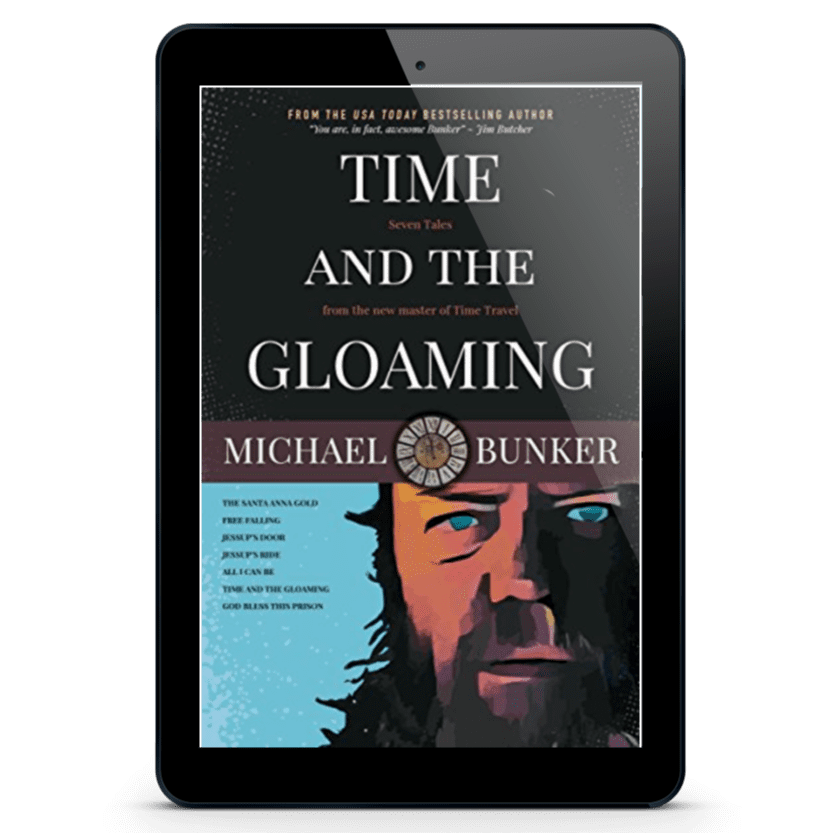
Hi Michael, Just the man and video I have been looking for. Do you have books on your hand rolling process?. I would love to purchase them. Have a million questions to ask you, what is the best way to receive hands on training in the way you roll cigars and where to find tobacco leaf and related cigar rolling equipment & supplies.
Best regards,
Roy Rayner in Omaha
My first cigar was at the age of 17. I had been deemed old enough by the local farmers who had gathered in my Grandparents barn that mid-November night. It was time for the annual stripping, and tying of the tobacco leaves into hands, reading them for sale. Picture a scene straight out of a Norman Rockwell painting, complete with a barrel fire to ward off the evening air. I was already seasoned at planting, topping, spiking and hanging to cure. Here now my initiation began with one old farmer removing a drug store cigar from his overalls, and wrapping a freshly stripped leave around it. Just imagine the laughs as I damn near coughed up a lung on the first draw.
40 plus years later, after smoking everything from hand-rolled to $700 Cubans, I can validate damn near everything as true that Michael has written. My favorites being Myth’s 6 and 7.
Myth #6, cigar ratings: they only apply to those certain individuals who can detect burnt earth cherry roots with a slight hint of Bavarian orange slices soaked in oaken truffles on their palate. They highest rated cigars are simply the ones that you like, be they hand-rolled, drug store or factory premiums.
Myth #7. Cuban cigars are not better – just different. They do have a unique flavor profile. Once you have a Cuban, spotting a fake is easy. The average person may think that money is the most counterfeited item in the world. The reality is that Cuban cigars are. Unless you purchase from a Habanos S.A. – you have a 99.9% chance of holding a fake Cuban in your hands. Remember that next time you are south of the islands and someone offers you an excellent price of a few hundred bucks for a glass top box of Cohiba’s! (Hint – Cubans don’t come in a glass top box.)
I would love to know more about your cigar rolling I have been rolling my own cigars for two years and I would love to know a little bit more than what I learned from the Internet on making your own cigars at home please contact me I would be honored to speak with you thank you very much have a great day . Bob in New Jersey
Thank you for debunking some of these myths about cigars. I especially appreciate your comments about premium cigars. It is good to know exactly what they mean by ages tobacco and what that does for a cigar. I will keep that in mind in the future!
Enjoyed your video in which you rolled a cigar. What do estimate the cost of that cigar was?
Thanks.